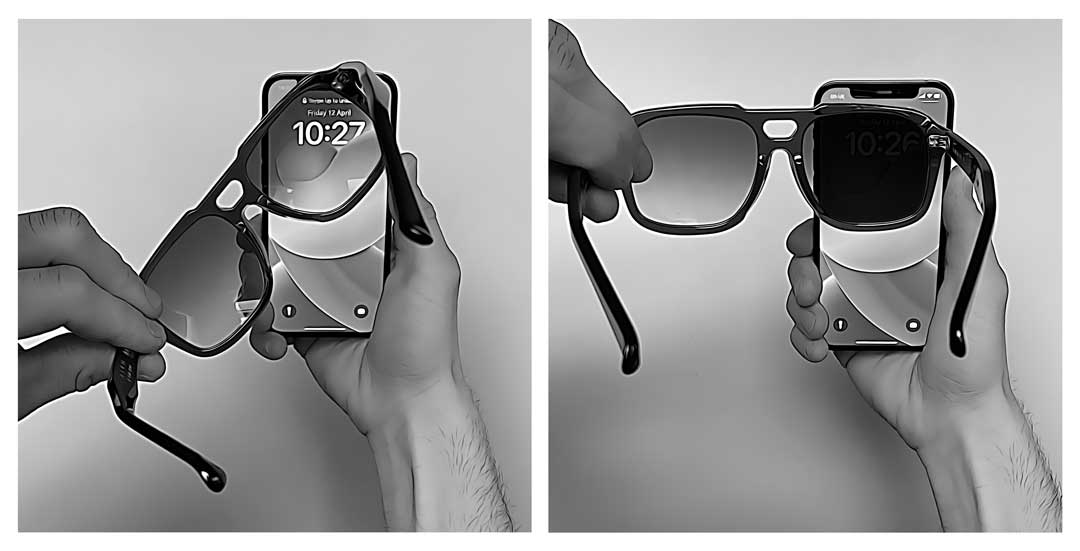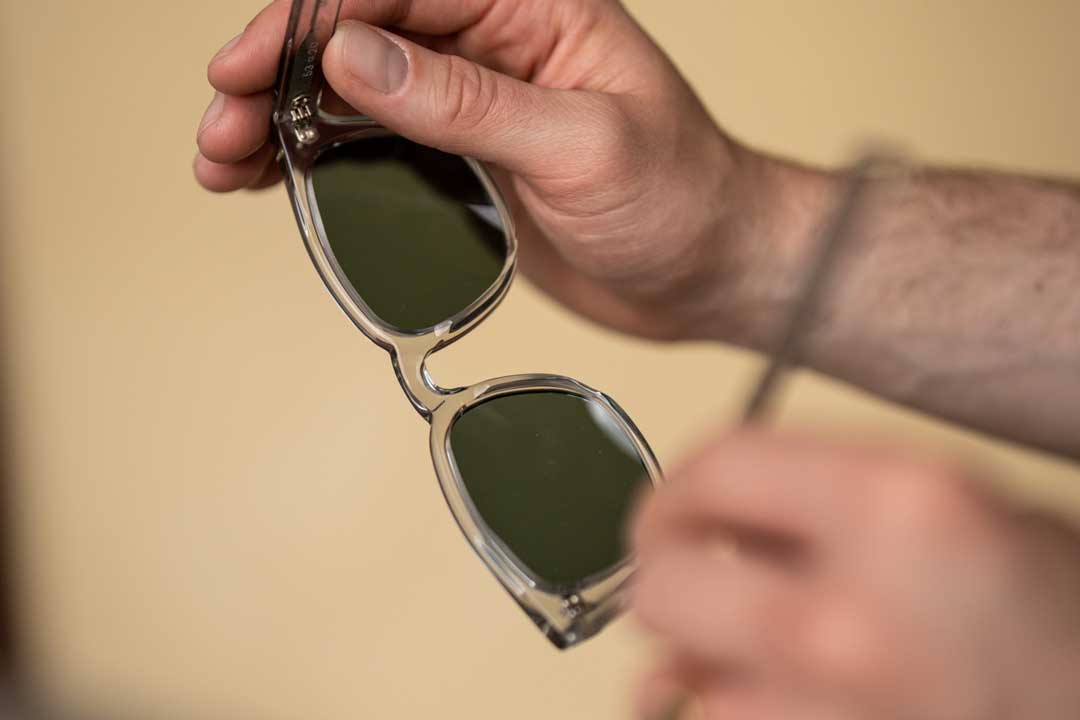Polarised sunglasses are like having a secret super power.
They drastically improve clarity, block glare, enhance your colour perception and even improve eye comfort.
But when they look just like regular sunglasses, how do you know if they're actually polarised?
This article provides two tried-and-tested methods to show you how to know if sunglasses are polarised or not.
Let's dive in.
Method 1: Polarised sunglasses test using a screen

One easy way to check whether you have polarised lenses is to hold them in front of a digital screen. This polarised sunglasses test is quick to do and can be conducted using just about any device that has an LCD screen. A smartphone or computer screen will work perfectly.
Follow these simple steps to determine whether you have a polarised pair of sunglasses:
-
Grab your mobile phone (any LCD screen device will work).
-
Hold your sunglasses at 90 degrees in front of the screen.
-
Look through the lens overlapping the screen while slowly rotating the frame so they're at the correct orientation.
-
Check whether there's a change in the brightness of the light.
-
If the screen darkens, the lenses are polarised.
Method 2: Polarised sunglasses test with two frames

If you're in a shop looking to buy some new sunglasses, you can quickly check if the sunglasses are polarised by using two separate frames. This hack is super handy and saves you asking the sales assistant (who's always helping someone else).
-
Hold your test frame in your right hand and another in your left.
-
Position the sunglasses so they're face to face, with each of their lenses overlapping (like the image above).
-
Rotate the sunglasses behind your test frame to 90 degrees while keeping the test frame level.
-
Look through the shared lenses.
-
If the brightness is reduced, then both lenses are polarised, but if there are no changes, the test glasses have non-polarised lenses.
FAQs

What are polarised sunglasses?
Polarised sunglasses contain a layer within each of the lenses called a polariser. This layer is type of chemical film which blocks glare from flat reflective surfaces such as water, snow, or wet roads.
Like regular sunglasses, polarised sunglasses also block UV light, but the polariser within their lenses helps reduce visual strain over long periods of sun exposure. This is why they're considered a superior type of lens as they less affected by strong reflected sunlight, whilst offering greater colour and depth perception.
To learn more about how polarised sunglasses work, check out this article.
Is it worth paying for polarised sunglasses?
While wearing polarised lenses is definitely beneficial, they cost an average of about 25% more than non-polarised equivalents. However, given the advantages they offer, they are certainly worth the extra cost.
Polarised lenses filter condensed sunlight much better than non-polarised lenses. Not only does this reduce eye strain, but can improve your safety during tasks such as driving. Sunlight or glare from oncoming traffic on wet roads might make it harder for you to see potential hazards, especially on long journeys where visual fatigue can start to compound.
Moreover, these glasses can help to improve the quality of your visual experience, as they enhance colour perception and can help you enjoy and appreciate the world around you.
If that's not enough to convince you of their value, then you need to know that they also filter UVA and UVB light, which vitally prevents damage to cornea and retina of your eyes.

What are the disadvantages of polarised glasses?
Like all things in life, there are both pros and cons associated with the use of these lenses. Polarised sunglasses downsides include the following:
- Polarised sunglasses are approximately 25% more expensive than non-polarised equivalents.
- Heavily darken LCD screens such as your phone, car displays or digital road signs.
- Reduce visibility in low light conditions which can be a disadvantage when driving at dawn, dusk, or in heavily shaded areas.
- Not good for certain sports such as skiing or motorbiking, as they can make it difficult to distinguish between ice patches and snow.
- Limited lens tint options (typically grey, brown or green) which offers less options for customisation.
- May cause nausea as they alter your perception of depth and distance.
Are polarised sunglasses better for your eyes?
Polarised sunglasses aren't any more protective for your eyes than non-polarised options. However, they can be more visually comfortable by blocking nearly all glare which reduces your likelihood of eye fatigue. Subsequently, headaches and squinting from extended exposure can be avoided.
Furthermore, polarised shades improve contrast and optical clarity, which enhances your ability to see colours and details. These advantages add to your overall comfort and visual experience, which makes polarised sunglasses a popular option for people who spend a lot of time outside.

Are polarised sunglasses 100% UV?
Regardless of polarisation, if the sunglasses are rated as UV400, they are indeed 100% UV protective. The primary function of any sunglasses frame is their ability to block ultraviolet light which any legitimate sun lenses should provide.
Polarisation is a secondary function of any sunglasses frame and is merely an upgrade to improve visual experience by blocking the effects of glare. Whilst it might sound better that lenses are polarised, this isn't remotely as crucial as UV protection.
What's the best UV rating for sunglasses?
UV400 is the best possible rating for sunglasses. This means the lenses block 99-100% of UVA and UVB rays which would otherwise be the most damaging to your eyes and skin.
In compliance to European standard EN 1836:2005 UV400 (or UV40) means a sun lens can block electromagnetic light frequencies up to 400 nano metres.
How can I test my sunglasses for UV protection at home?
You can test your sunglasses for UV protection at home by using an inexpensive ultraviolet torch. In a darkened room, shine the torch at one of the lenses to see if any light gets through. If no light passes through, it means your lenses are indeed UV protective.
How can I tell if my sunglasses have UV protection?
The best way to do this is to check the label to see whether it has a UV rating. Enquire about UV protection when purchasing your sunglasses to ensure that they have the specifications you're looking for.
Can sunglasses be both UV and polarised?
Yes. By law, any sunglasses sold legitimately must be rated as UV40/UV400 and provide 99-100% protection against ultraviolet light. Most, if not all legitimate polarised sunglasses will by default give full UV protection.
Conclusion
If you've been wondering, "How can I tell if my sunglasses are polarised?" we hope you found this article helpful. Here are some of the key takeaways:
- By simply rotating any sunglasses frame, you can check if the lenses are polarised if there's a significant change in darkness
-
Polarised lenses block nearly all reflected glare from flat reflective surfaces such as water, snow or wet roads.
-
Polarised lenses help reduce visual fatigue by diminishing reflected sunlight which taxes your eyes
- UV protection is mandatory, whilst polarisation is an optional upgrade
-
Not all sunglasses are polarised
- UV40 and UV400 mean the same thing; that sunglasses will block 99-100% of ultraviolet light.
Did you enjoy this article? If so, please check out our other polarised sunglasses blog posts for more helpful advice.